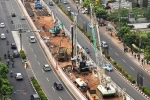MLFF to be tested on six toll segments
This article has been translated by PwC Indonesia as part of our Indonesia Infrastructure News Service. PwC Indonesia has not checked the accuracy of, and accepts no responsibility for the content.
Investor Daily - MLFF akan diuji coba di enam ruas tol
9 February 2023
Jakarta - The Toll Road Regulatory Agency (BPJT) of the Public Works and Housing (PUPR) Ministry will test the multi-lane free flow system on six toll segments in two phases this year. The initial phase will be tested on Bali-Mandara toll road in June, while the next phase will be tested on five other toll segments that represent 80% of the overall traffic on toll roads in Indonesia in December.
BPJT Secretariat Operation and Maintenance Head of the PUPR Ministry Ali Rachmadi said that the MLFF system would be expanded after the first test on Bali-Mandara toll road.
“At the start, only Bali-Mandara [toll road] in June 2023. We will see if the system has been tested or not. If it has, we will test it on the next five toll segments,” Ali said during a discussion with the PUPR Ministry in Jakarta on Wednesday (8/2/2023).
The other five toll segments where the system will be tested on after Bali-Mandara toll road are Jagorawi toll road, Jakarta-Cikampek toll road, Jakarta Inner Ring Road, Jakarta Outer Ring Road (JORR), and Balikpapan-Samarinda toll road.
“There are five toll segments that are prioritised for the test after Bali-Mandara toll segment. There is [the toll road] in Kalimantan that is Balikpapan-Samarinda, Jagorawi toll road, JORR, Jakarta-Cikampek toll road, and one more that I forgot. So, there are five toll segments after Bali-Mandara,” Ali explained.
Previously, BPJT Head Danang Parikesit said that the five toll segments where the MLFF will be tested on represented 80% of the overall traffic on toll roads in Indonesia.
The government is planning to implement MLFF at the end of this year. The full implementation of MLFF will be achieved in 2023 or 2024 after a series of tests and a transition period, which means that the MLFF implementation will not be simultaneously carried out on all toll segments.
The implementation will be continuously evaluated based on the success rate of the system to move on to the next phase. For the initial phase, the implementation will commence with a transition period on several toll segments where some toll booths will still use electronic toll road cards.
The MLFF-based non-cash transaction system relies on the global navigation satellite system (GNSS) where vehicle movement, when they pass through toll roads, will be detected using satellite technology. To use a toll road, users only need to press the start button on the toll road application on their smartphone before entering the toll road. Then, the GPS will determine their location according to the satellite, then a map-matching process will be carried out in the central system. When the trip ends and the vehicle exits the toll road, the map matching process will be terminated. Automatically, the application will calculate the tariff, then their balance will be deducted automatically.
Integration with ERP-ETLE
On the other hand, Ali revealed that the contactless non-cash toll road transaction system application, Cantas, can be integrated with other applications, such as electronic road pricing (ERP) and electric traffic law enforcement (ETLE).
“If possible, we will also integrate it with electronic road pricing (ERP),” Ali said.
Ali added that his agency had been invited by Jakarta Transportation Council. They hope to integrate it with the Cantas application. The application for MLFF, Cantas, can be a super app, similar to Pedulilindungi. However, BPJT is still preparing the Cantas application so that it can run excellently, then it will be integrated with other applications.
“I hope that everything will be in one application, so the people do not have to use many applications,” Ali said.
He also said that the MLFF technology would be integrated with ETLE for law enforcement.
“Regarding the integration with electronic traffic law enforcement (ETLE), we have held a discussion with the Traffic Corp of the Indonesian National Police (Korlantas Polri). We hope that it will be integrated,” Ali said.
BPJT Secretary Triono Junoasmono said that the PUPR ministry through BPJT was implementing MLFF as a form of innovation and digital transformation on toll roads by using the intelligent toll road system (ITRS) concept that refer to Toll Road Technology 4.0. Overall, the innovation of MLFF is a breakthrough for contactless transaction service on toll roads that can be implemented automatically using an application on a smartphone using a server-based system with the GNSS technology and vehicle data that is recognised by a satellite.
When the MLFF technology is implemented, toll road users can make non-cash payments without the use of cards by only downloading an application and registering their personal data on the application called Cantas on their smartphone that is connected to the internet. Then, after calculating the tariff on the application, their balance will be automatically deducted.
“With the system, toll road users will have a better user experience. It will also make operating costs more efficient and save fuel consumption. We know that, to mitigate climate change, we must reduce fossil fuel consumption, such as petrol,” Triono said.


















